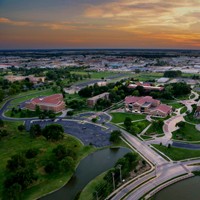After viewing the cover of the Fall 2013 Newman University Magazine, you will probably never look at Newman University the same way. That is, unless you’re in a helicopter.
The first edition of the Newman University Magazine celebrating our 80th Anniversary needed something different on the cover – a fresh, new perspective. The answer came from Wichita’s own Steve Rasmussen and the aerial photograph of the Newman University campus.
Newman University contracted with Rasmussen, one of Wichita’s premiere photographers, to give us an aerial view of the campus. A couple weeks after throwing Rasmussen on a helicopter, he did not return with a photograph. Instead, he returned with a historical icon – an image that will represent the face of Newman University for centuries. Or, at least until the next new building comes along and defines a new horizon.
We tried to catch up with Rasmussen several weeks after the shoot for a quick discussion. But of course, he was in the middle of a photo shoot. What follows are questions sent to Rasmussen in an email and his responses.
Q. What challenges were you confronted with when trying to get the right shot for this project?
A. The biggest challenge for these photographs was to make sure the light was going to be great. Chartering a helicopter is fairly expensive and you want to make sure you get the light you want. We were wanting to get a sunrise and sunset shot so timing was important.
Q. In what ways did you prepare for this project?
A. I’ve shot aerials many times, so the preparation was fairly routine. I scouted Newman in sunrise and sunset light, to see if there was anything that didn’t make sense. The campus is always in such beautiful shape that I wasn’t too concerned. Constantly checking the weather was a really important factor. Finding the right day was difficult because there was so much rain in Wichita this summer. From a technical perspective, I took a couple of cameras with me, as well as three different lenses and a couple of filters. I like to have everything with me at all times when I’m shooting, but a helicopter doesn’t lend itself to that kind of packing.
Q. How did you first get started doing aerial photography?
A. I had my first aerial experience when I was about 13. My parents had a weekly newspaper in Lincoln, Kan., and I remember shooting aerials of some localized flooding with my dad. He was shooting too. Good thing, because my roll of film (yes film) didn’t load properly and I ended up with nothing. I was heartbroken but learned a good lesson at the same time. I always try to shoot multiple cameras in aerial situations.
Q. How is the process of taking aerial photos different from the process of taking more typical landscape shots?
A. When I am working on a landscape shot, time and my tripod are my two biggest friends. In the air, I have no time and no tripod. Just a lot of thinking on your feet. I want to shoot fairly tight compositions so I don’t have to crop the image too much. I also try to shoot a bunch because of being in a constant state of moving.
Q. Describe your experience hanging out of a helicopter in order to get that perfect shot.
A. I love heights so helicopters don’t bother me too much. When shooting photography, the pilots will remove the door for you which makes it much more possible to maneuver. Definitely want to make sure your seat belt is secure before takeoff.
Q. Is there a lot of control in this type of photo shoot, or is it more of a “right place, right time” type of shoot?
A. Yes and yes. The control is doing your homework beforehand and removing as many obstacles as you can before the flight. Once you are in the air, it’s just a matter of communicating with the pilot and making it work. The time of day we shot was a little risky from a technical perspective, just because there wasn’t a whole lot of light in the sky.
Q. Do you prefer aerial photography over other types of shoots?
A. I love architectural photography and aerial feels like a fast paced adrenaline spinoff of that style. I also love shooting lifestyle, and people photography. I think if I had to shoot just one discipline all the time, I would be less fulfilled.
Q. What advice would you give to other photographers who are getting burnt out?
A. I would suggest trying different things if you are getting burned out. I am always trying to figure out different ways to shoot or light my images. The beautiful thing about photography is that there are so many different paths available.
Learn more about Steve Rasmussen on his website at
http://www.steverasmussenphotography.com

